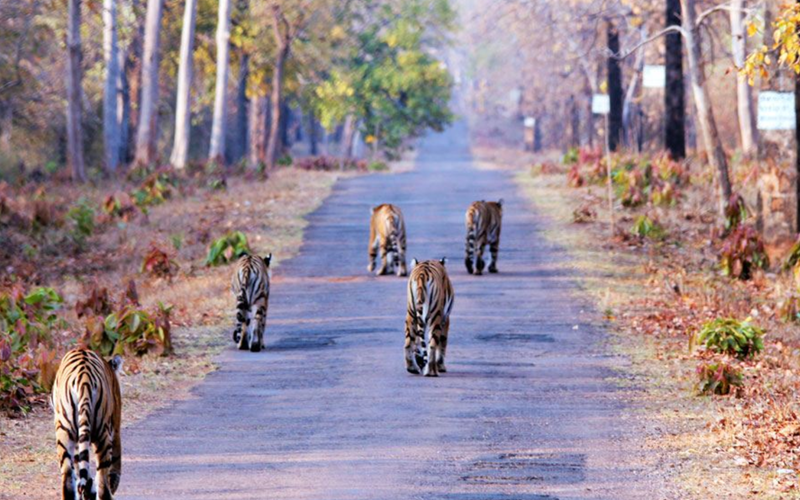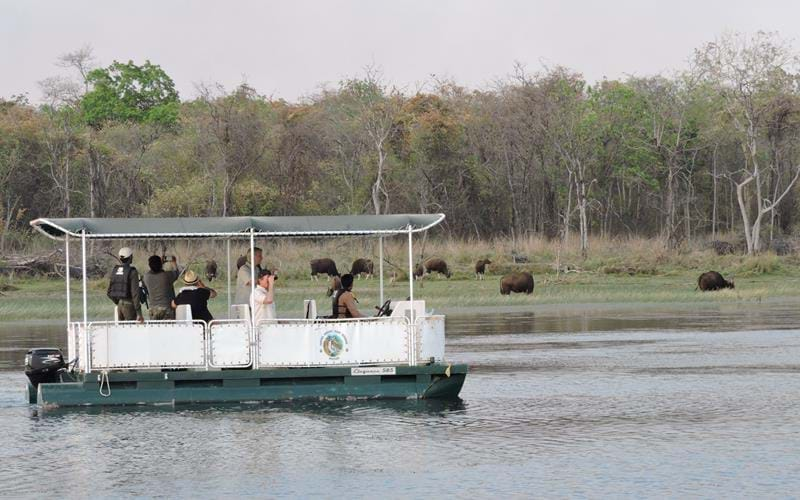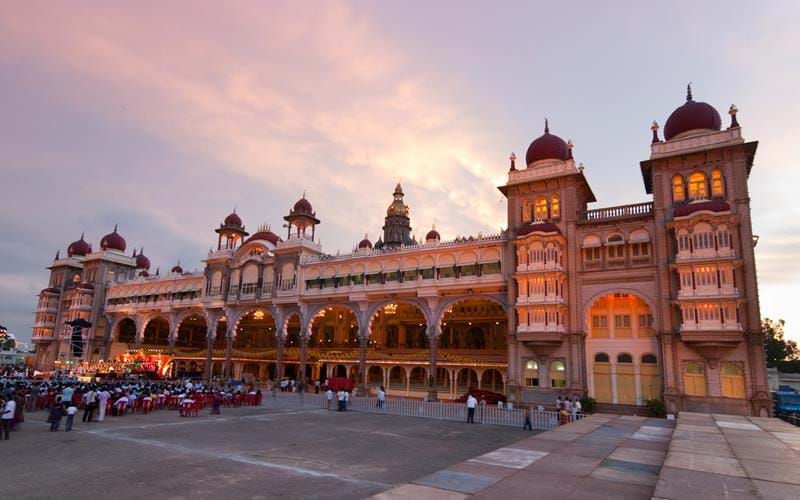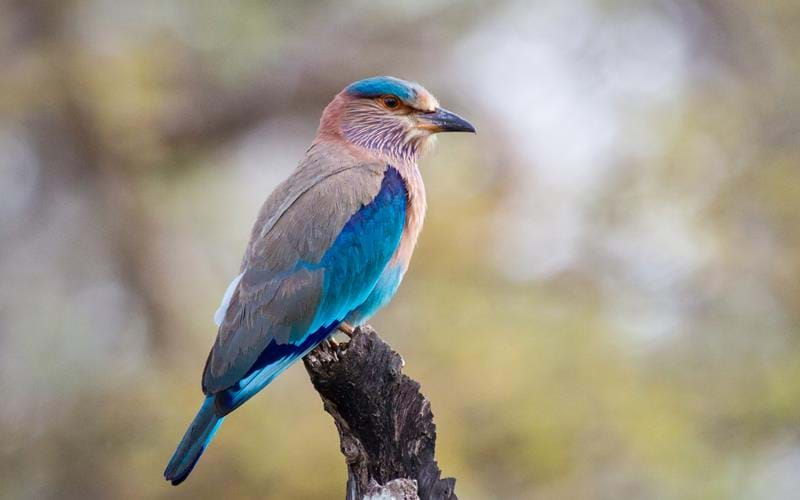Join TransIndus on a trip to the wild heart of central India, covering three of the country’s most remote and successful parks for their valuable…
View more
This is the ultimate of India's nature-based holidays! The term ‘Big Five’ refers to India’s most endangered and elusive mammals: one-horned rhinos, Asian elephants, leopards, Asiatic lions, and Royal Bengal tigers. Unlike in Africa, where all the major species can be sighted in a single reserve, you must travel to different national parks to see them all. But thanks to the country’s efficient, modern air network, it is possible to tick off the big five in a trip just shy of three weeks. You will, of course, see many other wonderful animals and exotic birds while visiting the four reserves featured on this itinerary, and you’ll experience three of the country’s largest and most atmospheric cities, in addition to a scattering of remote, rural villages and some fabulous landscapes.
Accommodation is in luxurious safari lodges, where you can experience the surrounding wilderness in great comfort, sleeping in richly furnished hunting tents, tree houses perched high in the jungle canopy, or cottages nestled in deciduous sal forest.
Cultural Holidays Wildlife Holidays River Cruising Holidays Luxury Train Holidays Family Holidays Honeymoons Beach Holidays Adventure Holidays
Fly overnight from the UK to Delhi.
On arrival in Delhi, you’ll be met by your TransIndus guide and driver and transferred to your hotel for a two-night stay in the Indian capital. Spend the remainder of the day recovering from your journey with a swim in the hotel pool. Depending on the location of your hotel, you might also be able to visit a nearby tomb garden at sunset, or go for a stroll at the Gurudwara Bangla Sahib, a Sikh temple near Connaught Circus.
Made of white marble and crowned by a gilded onion dome, the Gurudwara Bangla Sahib and shimmering pool inside it are places of great sanctity for Indian Sikhs, and offer the most atmospheric introduction possible to the capital. The complex in its present form dates from the late-18th century and was constructed at a place associated with the eighth Sikh Guru, Har Krishnan. At a Langar, or ‘canteen’ in the temple, pilgrims are fed free meals of chapatis and dal by volunteers. If you’re lucky you may see groups of Akalis Sikh warriors dressed in traditional ceremonial garb.
Enjoy a full-day’s sightseeing today, starting with a cycle-rickshaw ride or walking tour of Old Delhi, typically including the Jama Masjid mosque, the spice and silver bazaars of Chandni Chowk and Red Fort. In the afternoon, visit Lutyen’s imperial capital, Humayun’s Tomb, and the spectacular Qutb Minar complex on the southern outskirts.
The narrow lanes of Old Delhi once formed the hub of the Mughal capital, formerly known as ‘Shajahanabad’ after the Emperor Shah Jahan. Different streets are given over to different trades in this atmospheric district and before setting off, your guide will quiz you on your interests in order choose the sights most likely to inspire, whether street-food hot spots, crafts workshops or hidden architectural gems. Whatever your chosen itinerary, an obligatory stop should be the Jama Masjid, whose giant white domes dominate the skyline of the old city.
After admiring the extraordinary view from the mosque’s minarets, enjoy a home-cooked lunch in a traditional Mughal-era haveli before heading across town to see the landmarks of the former British capital, inaugurated in 1931. Humayun’s Tomb, one of the India’s greatest early Mughal buildings, stands in manicured gardens a little further south and may be visited en route to the iconic 13th-century Qutb Minar victory tower on Delhi’s southern fringes – the day’s final stop.
Fly from Delhi to Rajkot, in western Gujarat, and drive onwards to the Sasan Gir National Park for a two-night stay.
Gujarat ranks among India’s most developed regions. The country’s busiest ports lie on its coast and the main cities are large industrial centres. Life in the countryside, however, remains very traditional. Villagers in outlying regions like the one you’ll be visiting still mostly wear the old styles of dress and subsist off small-scale farming and livestock herding.
Sasan Gir has been at the centre of various controversies over the years. Local villages (many of which were relocated in the 1970s and 1980s to make way for the park) have been encroached upon by the big cats as their population has increased. More recently, plans to create a second lion reserve in neighbouring Madhya Pradesh have sparked debate in the Indian parliament.
Enjoy morning and afternoon game drives in the park today. Spend the warmer hours between safaris relaxing at your hotel, which has an outdoor pool in its grounds and first-rate recreational facilities as well as a choice of restaurants serving different cuisines. Sasan Gir village is only a ten-minute stroll away for those wanting to explore the area further.
Sasan Gir is internationally renowned as the last stronghold of an animal that only survives on the Saurashtra peninsula: the Asiatic lion. The local maharaja was responsible for setting the reserve up a century ago, after it was realized the local population of lions had been reduced to a mere 15. Today, over 520 inhabit the jungle, grasslands and acacia scrub of the Sasan Gir National Park, and good sightings are almost guaranteed. In addition to its lions, the park also supports large populations of leopard, as well as deer, antelope, sloth bear and around 300 species of birds.
After your early morning Jeep safari and breakfast at your hotel, re-join your car and driver for the transfer to Rajkot airport, where you’ll catch a flight to Mumbai. Spend the evening mingling with the crowds at the Gateway of India before dining at one of the many famous restaurants in nearby Colaba.
Before the last British troops garrisoned in the country slow-marched past it to board their ships back to Blighty in 1947, Mumbai’s Gateway of India – a huge triumphal arch in the colonial Indo-Sarcenic style – was the first landmark most new arrivals from Britain set eyes on. The second was the famous Taj Mahal Hotel beside it (then known as ‘Watson’s’). Both still stand tall on the waterfront, as emblematic of the city today as they were in Victorian times.
Enjoy a full day of sightseeing in Mumbai today, starting with a cruise across the harbour to Elephanta Island to see the famous cave temples. After lunch at one of the Mangalorean seafood restaurants or Irani cafés off Horniman Circle, enjoy a walking tour of the old Fort district, sampling some of its legendary street snacks along the way.
Hollowed from a hill of brown-black basalt 13 centuries ago, the pillared cave temples of Elephanta contain a series of awesome bas reliefs, the most iconic of them the three-headed ‘Trimurti’, representing the three aspects of the God Shiva. The journey to the island across the bay yields a memorable view of Mumbai, whose harbour was in British times the busiest in the empire, exporting cotton when supplies were cut off during the American Civil War.
Profits from this lucrative trade funded the construction of the splendid buildings that still line the grand streets of Fort, Mumbai’s commercial hub. Join a local expert for a history-focussed tour ticking off all the main landmarks, from the Prince of Wales Museum, GPO and VT Station to the wonderful Asiatic Library on Horniman Circle, with a re-vitalising stop at the old Yazdani Bakery along the way for chai and a traditional Parsi ‘biscoot’!
Transfer to the airport after breakfast for the 90-minute flight to Nagpur city, in the centre of India. After lunch, drive south across the Deccan Plateau to Tadoba, arriving mid-afternoon, in time for your first Jeep safari.
Tadoba National Park, or ‘the Taboba-Andhari Tiger Reserve’ to give it its official title, is the largest and oldest national park in the State of Maharashtra, and sufficiently off-the-beaten track to have escaped the attention of mass tourism, despite boasting one of the highest tiger density figures in the country. In short: it takes some effort to reach, but the payoff is a more vivid experience of an unspoilt environment which you will not have to share with dozens of other Jeeps and buses.
Nearly 87% of the reserve is covered in beautiful dry deciduous forest – a renowned storehouse of rare trees and medicinal plants. Over 60 tigers live within and around the park borders, along with leopard, wild dog, striped hyena, gaur, nilgai, sambar, chital, civet cats, marsh crocodiles and nearly 200 species of birds.
Spend the next two days tracking tiger in the park, with game drives in the morning and evening. Between safaris, relax back at your lodge or choose from the array of different outdoor and cultural experiences on offer in this pristine area of central India.
With Jeep safaris scheduled for early morning and late-afternoon, daytimes tend to be relaxed at Tadoba. While some clients are content to lounge with a book by the infinity pool, others prefer to get out and about, exploring the beautiful countryside around the park on foot in the company of the lodge’s naturalist guides and a local Gond scout. The adjacent forest is rich in birdlife, particularly raptors. Species to look out for include crested serpent eagles, honey buzzards and short-toed eagles. If you’re lucky you may also spot a paradise flycatcher flitting through the foliage.
Pontoon punting, canoe trips, cycling safaris and visits to local villages may also be arranged.
After breakfast, re-join your driver for the return journey to Nagpur airport, where you’ll catch an onward flight to Kolkata, in northeast India. On arrival, transfer to a hotel in the city for a two-night stay.
Kolkata, or ‘Calcutta’ as it was known prior to 2001, is the capital of West Bengal state, and India’s third largest city. The trading post originally founded by the East India Company in the 17th century served as the country’s capital until 1911, and still preserves much of its colonial architecture, from the crumbling mansions in Chowringhee to the grandiloquent Victoria Memorial, whose marble domes soar above the banks of the Hooghly River.
Find your feet with a tiffin stop at the College Street branch of the Indian Coffee House, where the waiters all wear ice-cream-wafer turbans and starched cotton tunics.
Enjoy a day’s sightseeing in the most charismatic of India’s four big metropoles, starting early in the morning on the banks of the Hooghly River.
This is a city where everyday sights often prove the most arresting: the flower sellers spreading out their wares in the dawn light at Mullick Ghat; the wrestlers exercising on the nearby riverside steps; the overloaded barges of straw arriving at Kumartuli Ghat, where voluptuous deities are fashioned out of clay for the annual Durga Puja festival; and the endless streams of rickshaws, trucks and pedestrians pouring across Howrah Bridge at rush hour.
Recommended activities here include a heritage walk around Dalhousie Square, where the grandest buildings from the Raj era still stand proud, a street food tour with a local expert to guide you through the city’s famous snacks, and a ride on one of the old British-style trams.
Transfer to the airport in the morning for your onward flight to Guwahati, capital of Assam, from where you’ll drive on to Kaziranga National Park for a two-night stay on the banks of the Brahmaputra.
The far northeast of India is the region least visited by foreigners, and as such offers a mouth-watering prospect for any traveller with a keen sense of adventure. The terrain ranges dramatically, from riverine plains and tarai grassland to jungle and montane forest. Flanked by rain-soaked hills to the north and south, its heart is the flat, low-lying Brahmaputra Valley, where the Kaziranga National Park is among the last strongholds of the one-horned rhinoceros.
Explore the park by Jeep on morning and afternoon drives, relaxing back at your lodge between safaris.
One-horned rhinos once ranged across the entire Gangetic Plain, but due to habitat loss, big game hunting and poaching (its horns are prized in Chinese medicine), numbers have dipped to under 3,000. Two thirds of them are confined to Kaziranga alone, where the population is now growing slowly. The revival is often cited as a conservation triumph, but it has been hard won. To combat poaching the Indian government conferred on park rangers powers generally reserved for soldiers attempting to quell civil unrest: in 2015, for the first time, more poachers were shot dead than rhinos. Kaziranga also boasts one of the highest tiger densities of any park and your chances of a sighting are very good.
Return to the Assamese capital after your morning safari for an overnight stay. You’ll have the evening to catch up on some last-minute souvenir shopping in the city’s silk and handicrafts emporia.
Guwahati, capital of Assam state, is a large, busy city on the Brahmaputra, visited mainly as a travel hub en route to more remote areas. It holds a handful of splendid medieval temples, dating from the era between the 13th and 19th centuries when the Brahmaputra Valley was ruled by the Ahom kings. Various royal treasures are displayed in the Assam State Museum, Guwahati’s main sight, whose collection of weapons, jewellery, and tribal artefacts make a good introduction to local culture. On display too are some fine examples of ‘muga’ silk. Sericulture was keenly promoted by the Ahoms as an export. Made from an endemic species of silk moth, it is still highly prized in India. You’ll find shimmering saris and finely woven traditional ‘makhala sadors’ on sale at local emporia, most of them produced in the nearby town of Sualkuchi, dubbed the ‘Manchester of Assam’.
Transfer to the airport in the morning to catch your flight to Bengaluru (Bangalore), from where you’ll continue by road to the city of Mysore (Mysuru) for a two-night stay.
Unlike Bangalore, Mysore, former capital of the Wadiyar Rajas in the south of India, has been largely bypassed by the dotcom revolution and retains plenty of traditional charm, particularly in its markets, which serve as important centres for the trade in sandalwood, incense and silk.
The stand-out sight here, though, is undoubtedly the Maharaja’s Palace – a fairy-tale confection in quintessentially Raj-era ‘Indo-Sarcenic’ style. Clad in 18-carat gold, hundreds of Mughal-style domes and Rajasthani cupolas crown the complex, which is illuminated every Sunday with 100,000 electric light bulbs.
Spend today exploring Mysore in the company of your TransIndus guide, beginning with the famous Devaraja Market.
A feast of South Indian sights and smells, Devaraja bazaar is the city’s principal source of fresh produce – and souvenirs for tourists! Look out for the conical piles of day-glo ‘kunkum’ powder – the defining photo opportunity – and Hindu deities carved from fragrant sandalwood. Numerous little Udupi restaurants cluster in the surrounding streets where you can refuel with a traditional Mysore ‘dosa’ before heading across town for a tour of the palace.
The illuminations tend to attract more attention on Sunday evenings, but the murals adorning the royal interiors are the real show stealers in the daytime. Created in the early 1900s, they offer a window of a lost world of glittering pomp, when the royals celebrated Dusshera with lavish processions involving thousands of participants and animals.
Re-join your driver and vehicle after breakfast for the drive to Nagarhole, South India’s premier national park, where you’ll arrive in time for an afternoon Jeep safari.
Created from the private hunting reserve of the Maharajas of Mysore, Nagarhole encompasses a tract of jungle-clad hills and the banks of a reservoir fed by the Kabini River. When water levels are low between February and March, elephants are enticed out of the trees to drink, along with herds of deer and antelope, and the predators that prey on them: striped hyena, dhole (wild dog) and even the occasional tiger.
In addition to towering teak trees, Nagarhole’s forest protects jungles of rosewood, silver oak and, most highly prized of all in this part of the world, sandalwood, which is used to make incense. Birdlife is also prolific, with 270 species recorded, among them the endangered Oriental white-backed vulture, Greater-spotted eagle and three kinds of hornbill.
Enjoy morning and evening Jeep safaris in the park, guided by an expert naturalist from your lodge. Between drives, consider signing up for one of the many outdoor activities on offer: boat cruises, kayaking and coracle trips on the Kabini River, or cycling and nature walks in the forest.
The woodland lining the banks of the Kabini is especially rich in birdlife, with around 300 species present, among them rare endemics such as the Malabar pied hornbill, Nilgiri flycatcher and the Malabar parakeet. You can see an amazing number of species just by following the trails around the lodge, but keen ornithologists are advised to take at least one spin on the river, whether by boat, kayak or coracle, to spot the many aquatic birds residing in this borderland between Tamil Nadu and Karnataka.
After an early morning drive in the park and breakfast back at the lodge, check out and rejoin your vehicle for the drive back to Bangalore, where you’ll be spending your final night in India.
Bangalore, renamed ‘Bengaluru’ in 2006, is the go-ahead, trend-setting capital of Karnataka state. As the home of India’s own Silicon Valley, the city has been at the forefront of the country’s IT revolution for the past two decades or more, and has a noticeably upbeat feel, with a hi-rise skyline of glass-sided towers to match.
Traces of Bangalore’s pre-colonial past include a scattering of splendid medieval temples, among them the 800-year-old Dharmarayaswamy near the centre, which you’ll have time to visit should you wish. Known as ‘The Garden City’ in British times, Bengaluru also has some pleasant parks where you can escape the traffic. Created in 1760 by Sultan Haider Ali and later enlarged by experts from Kew, the Mughal-inspired Lalbagh Botanical Gardens hosts regular flower shows in its giant glass house, modelled on London’s Crystal Palace.
Transfer to the airport in the morning for your return flight to the UK.
With the Summer almost upon us, now is the time to begin planning your next summer adventures in Asia. Our Travel Specialists are ready to take your call and discuss the adventure you have been dreaming of.
Or call us on 0208 566 3739

















